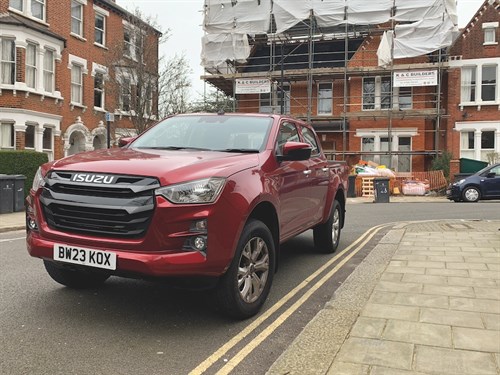- Inseego awarded Crown Commercial Service framework status
- ADVERTISEMENT FEATURE: Electrify and optimise: Digital solutions at the forefront of decarbonisation
- Fleets being pushed to take electric vans due to ZEV mandate, AFP reports
- Buying a used... Citroen Relay (2019)
- Fleetfind joins Fleetcheck affinity programme
- New LCV market growth continues, but EVs see steep fall
- Innovation award for Runyourfleet
- Orders open for Ineos Grenadier Commercial
- Toyota Hilux range gains new rally-inspired GR Sport II variant
- Remarketing: Pick of the bunch
Isuzu D-Max long-term test – Latest Report
Date: Thursday, April 25, 2024 | Author: James Dallas
3rd Report
The UK’s thriving pick-up sector is based upon the popularity of double-cab lifestyle models, which, being classed as commercial vehicles, benefit from a favourable tax regime that allows VAT to be reclaimed and ensures exemption from passenger car levels of benefit-in-kind (BIK) taxes, which scale upwards according to CO2 emissions, with a much lower standard flat rate paid instead.
In February, however, HMRC sent shockwaves through the sector by announcing that from 1 July even double-cab trucks with a 1.0t payload would cease to be classed as commercial vehicles and would be subjected to passenger car levels of BIK, which would have seen tax payments increase fourfold, largely due to the relatively high emissions of diesel pick-up trucks.
Although Isuzu built its reputation as a maker of robust, hardworking pick-ups and markets single and extended-cab models, which would have retained their commercial vehicle status under the new tax laws, it has also relied heavily on more luxurious, and bigger-selling, double-cab lifestyle models like the Blade, XTR and V-Cross.
A week after the taxation decision was announced, however, the sector was granted a reprieve when the government made a U-turn on the proposed changes, having, it said, listened to the concerns of the motor industry and farmers.
It may or may not have been a coincidence that on the day the government announced the U-turn Prime Minister Rishi Sunak was making a speech to the National Union of Farmers.

As a single-model brand the proposed change to the laws could potentially have dealt a huge blow to Isuzu’s business in the UK. Last year the D-Max was the UK’s third best-selling pick-up (6,315) behind the Ford Ranger and Toyota Hilux.
The 1.9-litre 164hp diesel engine that serves the entire D-Max line-up is comparatively low powered for a pick-up truck. Isuzu started using the engine in 2017 when it replaced the old 2.5-litre 163hp unit.
The differences in economy and emissions compared with bigger-engined competitors, however, are perhaps not as marked as might be expected. The manual D-Max Utility single-cab in both 4x2 and 4x4 modes, along with all the manual 4x4 double-cab models, have official CO2 emissions of 220g/km and fuel economy of 33.6mpg.
The 2.0-litre 170hp Ford Ranger 4x4 Ecoblue XL regular cab has figures of 226g/km CO2 and 32.8mpg, as does the XL double cab.
D-Max double-cab autos, though, emit 241g/km CO2 on the combined WLTP cycle and manage 30.7mpg. By comparison, the 2.0-litre 205hp Ranger Wildtrak auto has figures of 227g/km CO2 and 32.5mpg.
Turning to Toyota, the 2.4-litre 150hp Active single cab emits 249g/km CO2 with fuel economy of 28.5mpg but the Hilux Invincible X double cab manual with the newer 2.8-litre 204hp engine has official CO2 emissions of 225g/km and economy of 31.3mpg.
The claimed CO2 emissions and fuel economy figures for my D-Max DL20 on the combined cycle are 220g/km and 33.5mpg. With the majority of its time spent covering urban routes though, the fuel economy figure is currently falling well short. This should improve once the truck gets a few more extra-urban trips under its belt.
Report card: Fuel economy = 3/5
Fair to middling in the city but should improve on extra-urban assignments.
Isuzu DL20 Double Cab 4x4
Mileage 1,582mls
Official combined fuel economy 33.6mpg
Our average consumption 27.7mpg
Price range (ex VAT) £23,929-£35,779
Price (ex VAT) £29,679
Warranty 5yrs/125,000mls
Service intervals 12,000mls
Load length 1,495mm
Load width (min/max) 1,110/1,530mm
Gross payload 1,120kg
Braked towing weight 3.5-tonnes
Engine size/power 1,898cc/164hp
Gearbox 6-spd manual
CO2 220g/km
Options (prices ex VAT)
Tow bar £275.00
13 pin towing electrics £185.50
Over rail liner £247.50
View The WhatVan Digital Edition


